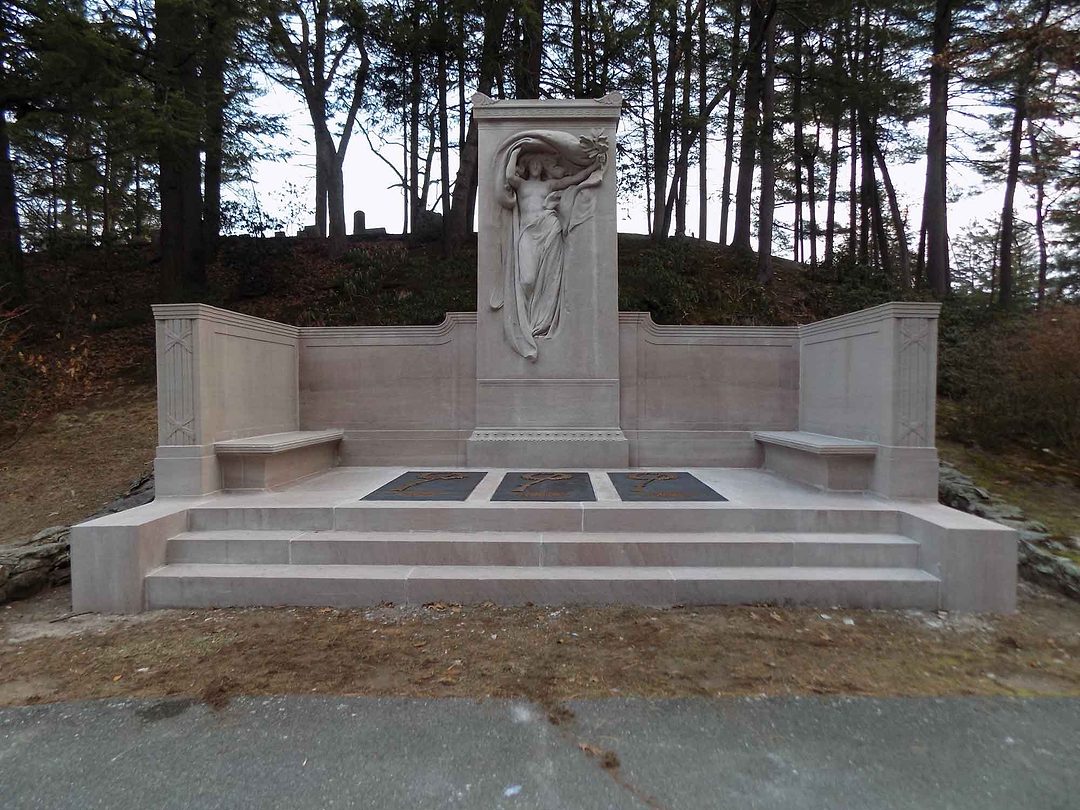Among the luminaries buried at Sleepy Hollow Cemetery, few made greater sacrifices for their nation than did Asa, John, and Samuel Melvin. Their story echoes down the years and reflects the courage, commitment and integrity of one of Concord’s oldest families.
The Civil War began on the morning of April 12, 1861 when Confederate forces fired on the Federal-held Fort Sumter in Charleston Harbor, South Carolina. Sumter surrendered after 36 hours of continuous bombardment. Two days later, President Abraham Lincoln issued a call for 75,000 volunteers to come to the country’s aid. Four years of bloodshed, in a war that would claim over 600,000 lives, had begun.
Nearly 160,000 Bay Staters would serve in the army and navy, and Concord did her part by sending 450 men off to war. Forty-eight of them would lose their lives on the battlefield or from disease. Among the Concord dead were three brothers, Asa, John and Samuel Melvin.

Before
| Courtesy of Concord Public Works
The Melvin family were longtime Concord residents and had long been involved in the town’s history. One of their ancestors, Amos Melvin, rang the Concord courthouse bell on that fateful morning of April 19, 1775 when Dr. Samuel Prescott warned “the British are coming!”
Asa was the oldest and was the first to volunteer in April 1861. His three-month term of enlistment ended after the Battle of Bull Run, but he re-enlisted and was joined by two of his brothers, John and Samuel. All three would serve in Company K, 1st Massachusetts Heavy Artillery. James, the youngest brother, could not join the army in 1861, but would do so in 1864.
In the spring of 1864, General U.S. Grant’s Overland Campaign needed men, lots of them. He decided to move heavy artillery forces out of the forts and onto the front lines in Virginia. Men who had seen very little fighting – including the three eldest Melvin brothers - would now take part in some of the bloodiest battles of the war as Grant moved against Robert E. Lee and the Confederate capital at Richmond.
John Melvin would be the first of the three brothers to die. In fact, he never made it to the fighting, succumbing to dysentery at the Fort Albany military hospital in Virginia before the campaign even began. John is buried in the Melvin family plot in Sleepy Hollow Cemetery. Asa would be killed on June 16 during the Siege of Petersburg, shot in the chest and buried in a mass grave on the battlefield. Sam Melvin was captured by the Confederate Army shortly after the Battle of Spotsylvania in May 1864 and sent to the infamous Andersonville prison in Georgia. He would languish there until September 25, 1864 when he died of disease and malnourishment. He is buried in Andersonville National Cemetery.
![Melvin-Memorial-Close-Up-[tiff]-8511.jpg](https://www.discoverconcordma.com/ext/resources/2024/09/16/Melvin-Memorial-Close-Up-%5Btiff%5D-8511.jpg?1726513311) © BayColonyMedia.com
© BayColonyMedia.comThe youngest brother, James, was stationed far from the fighting and had the good fortune to return to Concord unscathed. He became a successful Boston businessman. But, as the years passed, he never forgot his brothers. He vowed that someday he would dedicate a monument to their sacrifice. And he knew just the man to create that monument - his longtime friend (and Concord resident) Daniel Chester French.
By the late 19th century, French was the preeminent sculptor in America. His first real claim to fame was his 1875 Minute Man statue that still stands at Concord’s Old North Bridge. French would go on to create a number of famous works, including the statue of John Harvard in Harvard Yard (1884), the Pulitzer Prize gold medal (1918), and in 1920 perhaps, his most famous sculpture, the huge seated figure of Abraham Lincoln that graces the Lincoln Memorial in Washington, D.C.
In 1897 French was commissioned by James Melvin to create “Mourning Victory”, a marble memorial in the classical Italian Renaissance style. In the center of the shaft stands “Victory”, shrouded in an American flag, looking down on three bronze plaques that bear the names of Asa, Samuel, and John Melvin. With downcast eyes, it is obvious that Victory, along with James Melvin, is mourning the loss of her three Concord sons.
The monument was completed in 1908 and placed in Sleepy Hollow Cemetery. It was dedicated on June 16, 1909, the 45th anniversary of Asa’s death during the Siege of Petersburg. Eighty-eight veterans of the 1st Massachusetts Heavy Artillery were in attendance, brought to Concord from Boston in two special railroad cars. There were prayers for the three Melvin brothers, “who showed their love for their imperiled country” by laying down their lives. The Grand Army Glee Club sang Civil War songs, including The Battle Hymn of the Republic.
During the ceremony Lieutenant Peter D. Smith spoke of the Melvins’ sacrifice saying they “gave the best of their years to the service of our country...their battle has been fought, their victory won, and they are now awaiting for those of us who tarry here a little longer, to come and join with them in the grand parade above.” After the services concluded, the aged veterans were escorted to the Colonial Inn, where James Melvin hosted the group as his guests for dinner in the main dining room. James spoke to the veterans, saying that he was “deeply touched” that so many of them had come to Concord to honor his brothers.
Interestingly, the Melvin Memorial is not the only version of ”Mourning Victory.” Four years later, James Melvin commissioned French to do another one for the Metropolitan Museum of Art (MET) in New York City. In fact, Melvin himself donated the funds to the Met in order to have the replica created. Dedicated in 1915, the MET version is slightly different. In the statue at the MET, ”Victory” has her right arm outstretched with her left arm upraised, the exact opposite of the Sleepy Hollow version. This was actually French’s original design for the monument, and when Melvin commissioned him for the MET version, French carved it according to his original design. French had altered the Cemetery version because of its placement, which would have had visitors to Sleepy Hollow come down a path and see the statue’s face covered by her upraised elbow. By changing the arm positions, visitors would now see ”Victory’s” unobstructed face.
The original ”Mourning Victory” still stands in Sleepy Hollow today. Known locally as “The Melvin Memorial”, a century’s worth of New England weather had taken its toll on the marble, bronze, and slate, leaving the monument cracked and discolored. In response, the Sleepy Hollow Cemetery Committee and Concord Public Works undertook a complete restoration of the memorial, begun in August of 2018, that included thoroughly cleaning the memorial, repointing the joints between the marble, filling small cracks and spalls, and replacing the three slate tablets.
With restoration completed, “Mourning Victory” was celebrated by Concord in a rededication ceremony on June 16, 2019, one hundred and ten years after the original dedication. James Melvin’s vision, brought to life by Daniel Chester French’s art, is once again a beautiful and fitting tribute to three brave Concordians who gave their lives for the Union.
Roe, Alfred S. (Alfred Seelye), 1844-1917, ed; Riverside Press (Cambridge, Mass.) The Melvin Memorial. Sleepy Hollow Cemetery, Concord, Massachusetts, a Brother’s Tribute; Exercises at Dedication, June 16, 1909.
This article originally appeared in the Summer 2019 issue of Discover Concord. It has been updated for republication.


